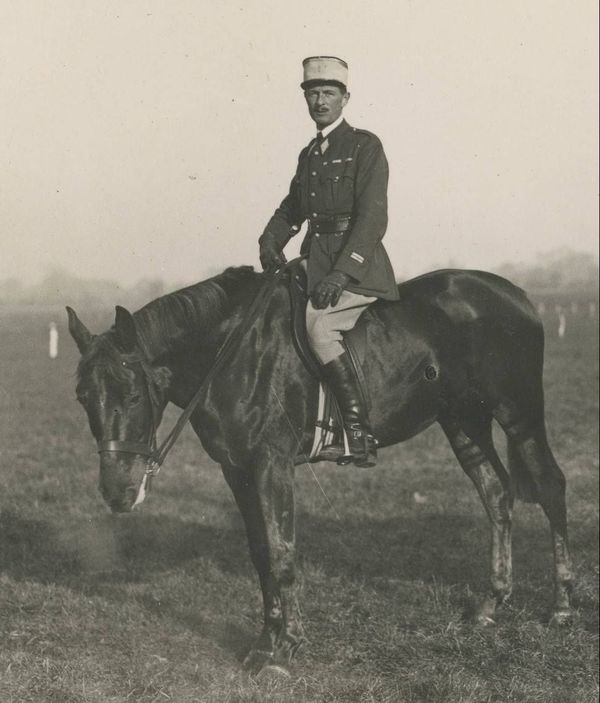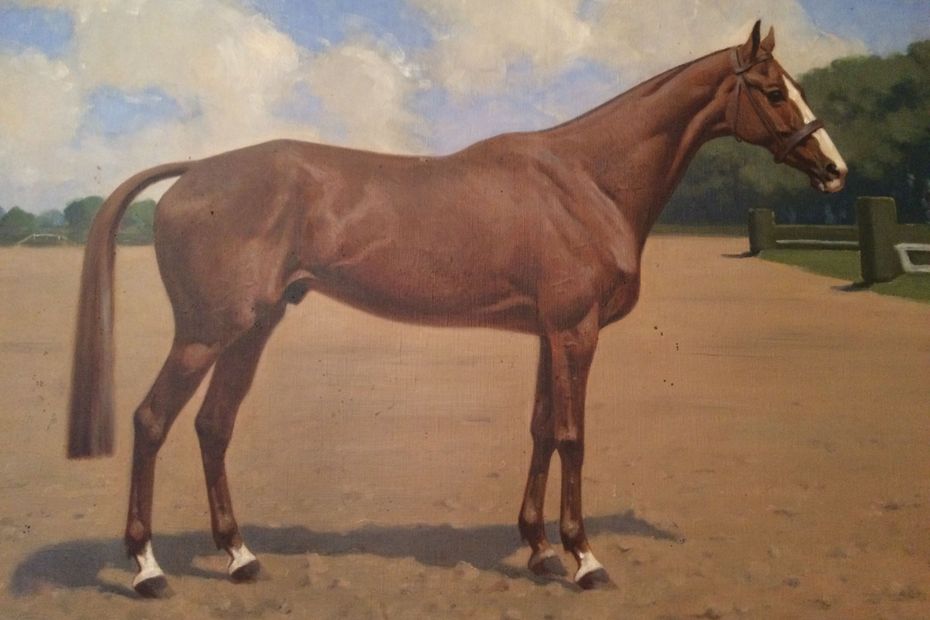Battle horse, race horse, rebel horse. He was the mount of Captain de Hautecloque, future Marshal Leclerc, during the Second World War, before being shot by the Germans for rebellion.
–
It is undoubtedly the only horse executed during the Second World War. Obviously, a war is above all a human tragedy. But, is it not singular that the martyrdom of an animal can also be a symbol of absurdity, arbitrariness and cruelty. In my eyes, the circumstances of the death of the horse Iris XVI are a very sad confirmation of this.

Captain de Hautecloque on his horse Iris XVI
•
© Museum of the Liberation of Paris – Museum of General Leclerc – Jean Moulin Museum
–
The story begins in 1936. It is set in the Cavalry Quarter of the prestigious École Militaire de Saint-Cyr, near Versailles.


The military school of Saint-Cyr, near Versailles
•
© Henry Salomé – Architects: François Michel Le Tellier de Louvois and Jules Hardouin-Mansart
–
At the beginning of each spring, it is customary to assign the squadron’s officer cadets a barely broken-in 5-year-old horse. In charge then remains with the young soldiers, to ensure the training. The choice of the man-horse pair is up to the captain of the squadron, a certain Philippe de Hautecloque, Picard who has the reputation of being an incorrigible “pète-sec”.
Thirty students therefore wait without saying a word for the chief’s decision. Among them, François d’Ussel, brilliant element and one of the best ranked. He would like to be given a beautiful Anglo-Arab mare spotted in the stables. A dream quickly vanished when the captain of Hautecloque said to him in a dry tone: “You! Take this one!“Matching the action to the word, he points to a large horse not very well formed called Iris XVI.
For any reaction, a “Well my captain“reminds us that in the army, we do not discuss orders.
Bet on the right horse
Three months later, the training seems well advanced. But an incident occurs during an exercise. The students and their mounts must gallop behind the group leader, a non-commissioned rider from the Cadre Noir of Saumur. The instructions are simple, never try to exceed it.
However, five hundred meters after the start, François d’Ussel sped towards the finish line, which he reached with more than twenty lengths ahead of the rest of the group. What to make both furious and pensive, his captain who has not lost anything of the scene.
A week goes by. The school is preparing to go on a maneuver in the Aisne, at the Sissonne camp. On the morning of the start, François d’Ussel had no idea that a bad surprise awaited him at the stable. Iris VXI has disappeared, replaced by an unknown horse. But who could have had the audacity to substitute his animal for him? The answer leaves him speechless, it is Captain de Hautecloque himself! Bis repetita, for the second time, we must grit our teeth and submit.
The men are gathered. Direction Versailles station where the squadron is to embark. But when de Hautecloque passes the stable door, Iris XVI swerves, lies down and crushes her rider. At the hospital, a bad shin fracture is diagnosed. The officer will keep all his life from the aftereffects that will force him to lean on a cane clearly visible in most photographs.


Philippe Leclerc de Hautecloque with his cane
•
© Museum of the Liberation of Paris – Museum of General Leclerc – Jean Moulin Museum
–
Time is passing. Not resentful, the captain now assigned to the Paris War School, never misses an opportunity to come to Saint-Cyr to ride his horse. The quadruped, a true champion of the racetracks, has become famous by winning numerous events. A reputation which made him too precious and offered him the privilege of not being “mobilized” when war broke out in 1939.
Iris XVI the rebellious horse
Alas, after the German rush on France in May 1940, the events will precipitate. On June 14, a few hours after the parade of the first Nazi troops in Paris, a detachment of German cavalry took over the Saint-Cyr school. The officer commanding this unit makes a request upon arrival: “You have in your stables an excellent horse named Iris XVI. This horse beat mine in a race. Go get it for me!“
An old groom just points to the box. A German soldier then grabs a halter and tries to drag the horse out of the stable. As he walks through the door, Iris XVI hits him with a masterful hoof. The man collapses, killed dead.
Mad with rage, the officer orders: “Put that horse on the wall and bring twelve men! This horse will be shot for rebellion“. A few minutes later, a platoon is formed. The order is carried out. Thus dies the horse of the future Marshal Philippe” Leclerc “of Hautecloque. Hearing of the disappearance of his dear companion, this one would have declared:”He was as patriotic as me“.
But the story does not end there. In November 1944, Captain de la Horie, officer of the second DB commanded by Leclerc, was killed in front of Strasbourg. The Jeep in which he was seated bore the name of Iris XVI on its windshield.
Our Picard hero will never forget his horse.


Painting representing Iris XVI, in the study of the Hautecloque family castle
•
© Jean-Paul Delance – Hautecloque family
–
A painting painted the year of the entry into the war represents him. He still appears today in a place of honor in the study at the family château of Tailly-l’Arbre-à-Mouches, near Amiens.
–

